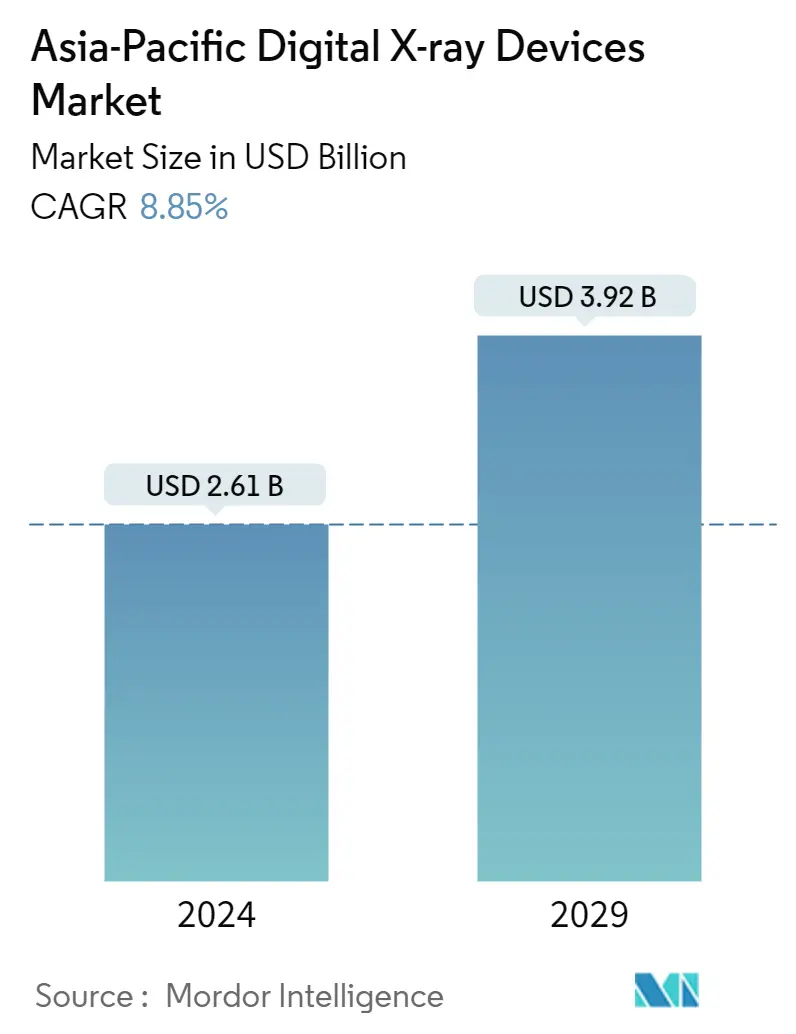Market Size of Asia-Pacific Digital X-ray Devices Industry

| Study Period | 2019 - 2029 |
| Base Year For Estimation | 2023 |
| Market Size (2024) | USD 2.61 Billion |
| Market Size (2029) | USD 3.92 Billion |
| CAGR (2024 - 2029) | 8.85 % |
| Market Concentration | Medium |
Major Players
*Disclaimer: Major Players sorted in no particular order |
Need a report that reflects how COVID-19 has impacted this market and its growth?
Asia-Pacific Digital X-Ray Devices Market Analysis
The Asia-Pacific Digital X-ray Devices Market size is estimated at USD 2.61 billion in 2024, and is expected to reach USD 3.92 billion by 2029, growing at a CAGR of 8.85% during the forecast period (2024-2029).
- The COVID-19 pandemic turned the spotlight on diagnostic imaging, particularly on digital X-ray devices. Digital imaging played a key role in the diagnosis of COVID-19 and indicated the affected lung tissue in infected patients. Several key market players had focused on innovations in the production of radiography equipment and had launched products that proved important during the COVID-19 crisis. For instance, an article published in the Clinical Imaging Journal in January 2021 stated that chest computed tomography and digital radiography were extensively used as a definitive diagnosis and reexamination in the radiology department of Sichuan Provincial People's Hospital in China to cope with COVID-19.
- The studied market growth can largely be attributed to factors such as the increasing occurrence of orthopedic diseases and cancers, the increasing number of serious injuries, the advantages of digital X-ray systems over conventional X-rays, technological advancements, and product development.
- The major advantages of digital imaging are cost-effectiveness and easy accessibility. The hospitals can control their spending by lowering the cost of films, requiring less storage space and employing fewer staff to manage the services and archives. For instance, according to a December 2021 article in the Research (Wash D.C.) Journal, the development of computed radiography has sparked a technological advancement for digital X-ray imaging with more accurate and immediate information. Compared to traditional X-rays, digital X-rays expose patients to about 70% - 80% less radiation. The long-term health of patients will greatly benefit from this, especially pregnant women or patients who are already suffering from illness, thus ensuring safety. Therefore, the advantages provided by digital X-rays are estimated to propel the market growth during the forecast period.
- Also, due to the increase in the number of dental disorders, cardiac disorders, and cancers, especially breast cancer, there is an increased demand for digital ray devices globally. For instance, as per the Australian Bureau of Statistics article updated in March 2022, the prevalence of heart disease in Australia was 4.0%, representing one million people in 2021. Heart disease increased with age, from 2.3% of people aged 45-54 years to 23.2% of people aged 75 years and over.
- Also, as per World Health Organization's (WHO) October 2021 update, the prevalence of stroke is on the rise in India, with 18 lakh stroke cases annually. Such a high prevalence of cardiac disease among the population in the Asia-Pacific region reaped the demand for imaging devices with precise diagnosis, and hence, digital X-ray devices have acquired their importance in this context.
- Additionally, the advancements in technology and increasing product approvals, along with partnerships and collaborations by key players, are helping in the market growth. For instance, in June 2021, LG Electronics launched a digital X-ray detector (DXD) with artificial intelligence (AI) solutions to expand its presence in the medical equipment field. The company was expected to launch its new DXD in global markets, including South Korea. Such a launch of highly effective portable devices for imaging applications might, therefore, anticipate the demand for digital X-ray devices and drive market growth.
- Thus, the aforementioned factors, such as the high prevalence of cardiovascular diseases and technological advancements in digital x-ray products, are currently augmenting the growth of the digital X-ray devices market. However, the high installations and device costs, along with the rise in the use of refurbished devices, are expected to restrain the market growth.
